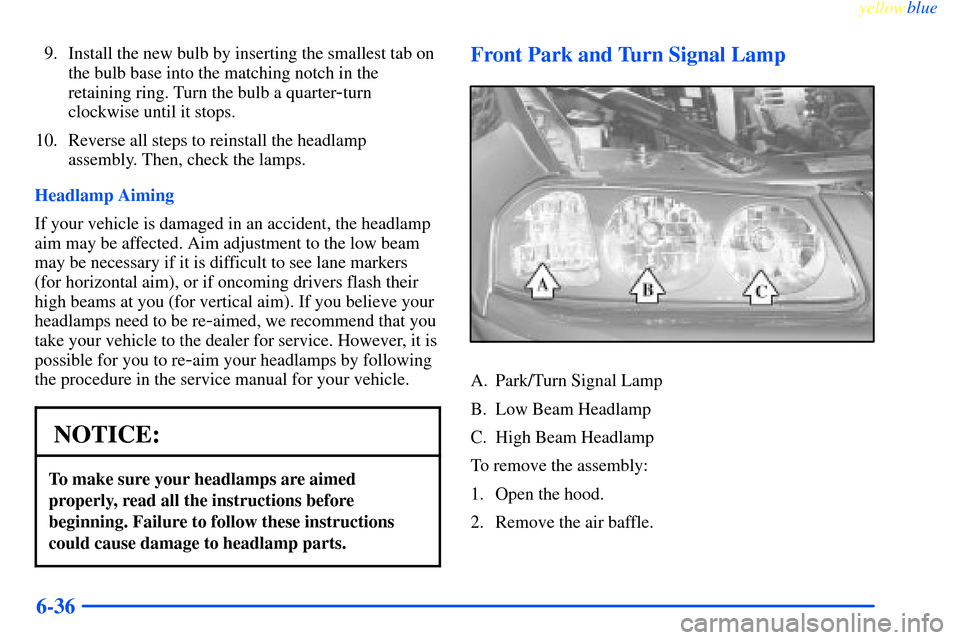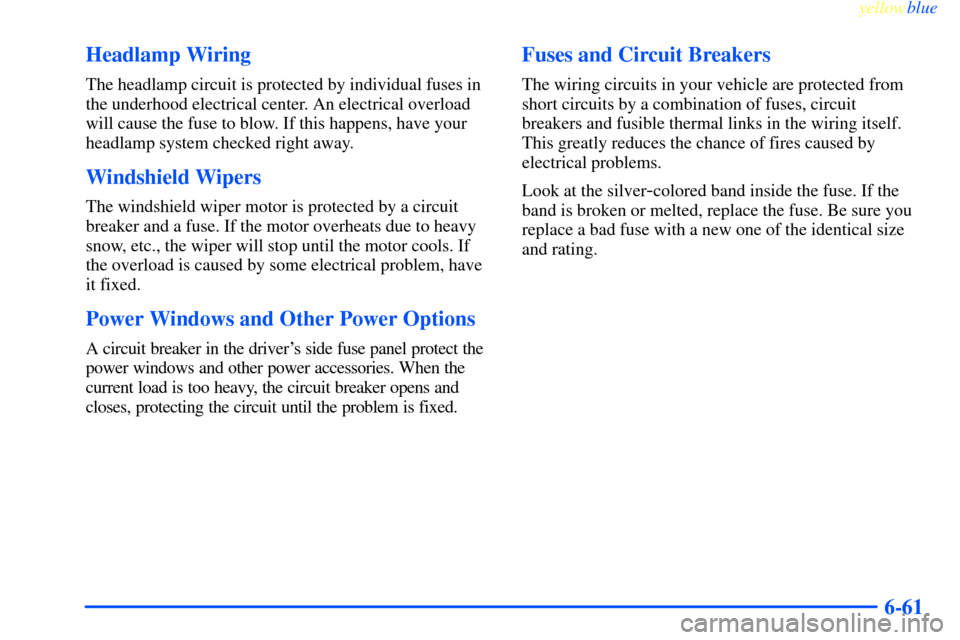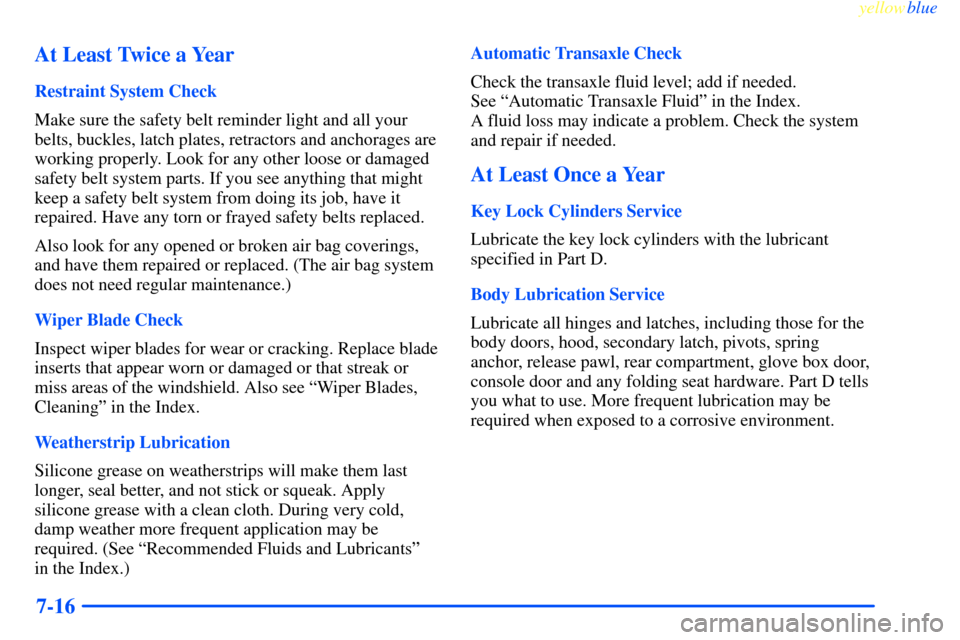Page 291 of 365
yellowblue
6-34
Bulb Replacement
For the proper type of replacement bulb, see
ªReplacement Bulbsº in the Index. For any bulb
changing procedure not listed in this section, contact the
service department of your dealer.
Halogen Bulbs
CAUTION:
Halogen bulbs have pressurized gas inside and
can burst if you drop or scratch the bulb. You or
others could be injured. Be sure to read and
follow the instructions on the bulb package.
Headlamps
A. Park/Turn Signal Lamp
B. Low
-Beam Headlamp
C. High
-Beam Headlamp
To remove the headlamps:
1. Open the hood.
2. Remove the air baffle.
Page 293 of 365

yellowblue
6-36
9. Install the new bulb by inserting the smallest tab on
the bulb base into the matching notch in the
retaining ring. Turn the bulb a quarter
-turn
clockwise until it stops.
10. Reverse all steps to reinstall the headlamp
assembly. Then, check the lamps.
Headlamp Aiming
If your vehicle is damaged in an accident, the headlamp
aim may be affected. Aim adjustment to the low beam
may be necessary if it is difficult to see lane markers
(for horizontal aim), or if oncoming drivers flash their
high beams at you (for vertical aim). If you believe your
headlamps need to be re
-aimed, we recommend that you
take your vehicle to the dealer for service. However, it is
possible for you to re
-aim your headlamps by following
the procedure in the service manual for your vehicle.
NOTICE:
To make sure your headlamps are aimed
properly, read all the instructions before
beginning. Failure to follow these instructions
could cause damage to headlamp parts.
Front Park and Turn Signal Lamp
A. Park/Turn Signal Lamp
B. Low Beam Headlamp
C. High Beam Headlamp
To remove the assembly:
1. Open the hood.
2. Remove the air baffle.
Page 295 of 365
yellowblue
6-38
9. Install the new bulb by inserting the smallest tab on
the bulb base into the matching notch in the
retaining ring. Turn the bulb a quarter
-turn
clockwise until it stops.
10. Reinstall the dust caps and reconnect the
electrical connector.
11. Install the headlamp assembly back to the vehicle.
12. Attach the air baffle.
13. Close the hood.
Fog Lamps (If Equipped)
1. Remove the T15 TORX� screw.
2. Pull out the lamp assembly.
3. Remove the old bulb. Do not discard! The
replacement number is printed on the bulb.
See ªReplacement Bulbsº in the Index for
more information.
4. Insert new bulb into the assembly.
5. Reinstall the lamps and screw.
Tail/Stop/Turn Signal Lamp
A. Rear Sidemarker Lamp
B. Tail/Stop/Turn Signal Lamp
To remove the rear lamp assembly:
1. Open the trunk. Remove the convenience net, if you
have one. Unhook the net from the upper wing nut.
Page 318 of 365

yellowblue
6-61 Headlamp Wiring
The headlamp circuit is protected by individual fuses in
the underhood electrical center. An electrical overload
will cause the fuse to blow. If this happens, have your
headlamp system checked right away.
Windshield Wipers
The windshield wiper motor is protected by a circuit
breaker and a fuse. If the motor overheats due to heavy
snow, etc., the wiper will stop until the motor cools. If
the overload is caused by some electrical problem, have
it fixed.
Power Windows and Other Power Options
A circuit breaker in the driver's side fuse panel protect the
power windows and other power accessories. When the
current load is too heavy, the circuit breaker opens and
closes, protecting the circuit until the problem is fixed.
Fuses and Circuit Breakers
The wiring circuits in your vehicle are protected from
short circuits by a combination of fuses, circuit
breakers and fusible thermal links in the wiring itself.
This greatly reduces the chance of fires caused by
electrical problems.
Look at the silver
-colored band inside the fuse. If the
band is broken or melted, replace the fuse. Be sure you
replace a bad fuse with a new one of the identical size
and rating.
Page 343 of 365

yellowblue
7-16 At Least Twice a Year
Restraint System Check
Make sure the safety belt reminder light and all your
belts, buckles, latch plates, retractors and anchorages are
working properly. Look for any other loose or damaged
safety belt system parts. If you see anything that might
keep a safety belt system from doing its job, have it
repaired. Have any torn or frayed safety belts replaced.
Also look for any opened or broken air bag coverings,
and have them repaired or replaced. (The air bag system
does not need regular maintenance.)
Wiper Blade Check
Inspect wiper blades for wear or cracking. Replace blade
inserts that appear worn or damaged or that streak or
miss areas of the windshield. Also see ªWiper Blades,
Cleaningº in the Index.
Weatherstrip Lubrication
Silicone grease on weatherstrips will make them last
longer, seal better, and not stick or squeak. Apply
silicone grease with a clean cloth. During very cold,
damp weather more frequent application may be
required. (See ªRecommended Fluids and Lubricantsº
in the Index.)Automatic Transaxle Check
Check the transaxle fluid level; add if needed.
See ªAutomatic Transaxle Fluidº in the Index.
A fluid loss may indicate a problem. Check the system
and repair if needed.
At Least Once a Year
Key Lock Cylinders Service
Lubricate the key lock cylinders with the lubricant
specified in Part D.
Body Lubrication Service
Lubricate all hinges and latches, including those for the
body doors, hood, secondary latch, pivots, spring
anchor, release pawl, rear compartment, glove box door,
console door and any folding seat hardware. Part D tells
you what to use. More frequent lubrication may be
required when exposed to a corrosive environment.